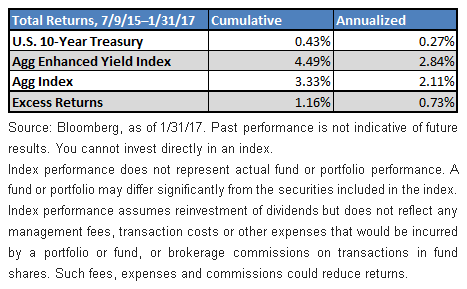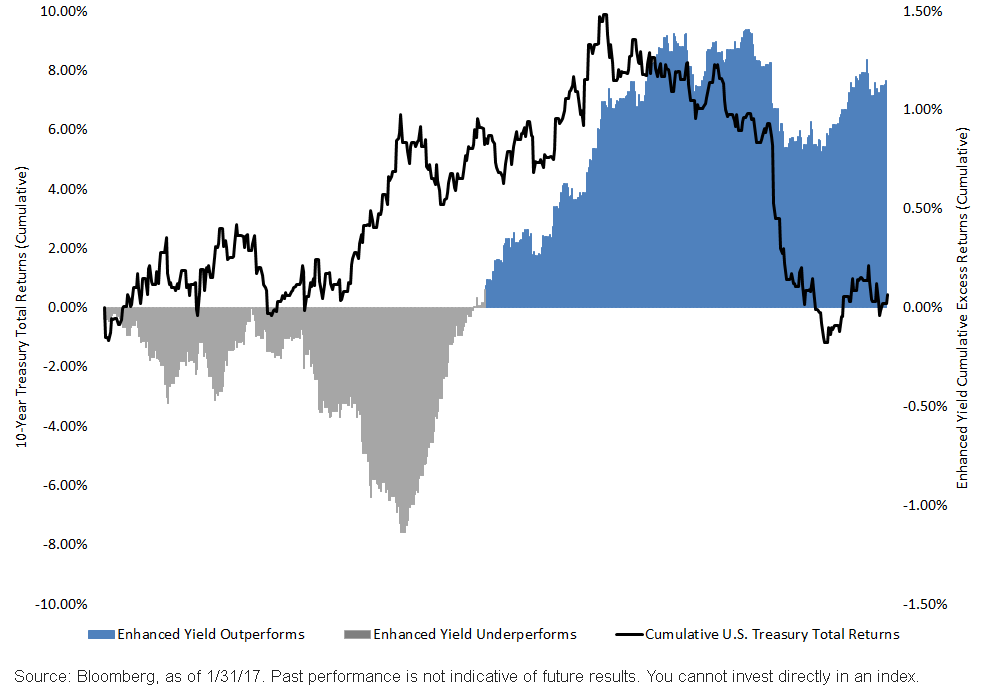Credit vs. Rates: What Has Been Driving Performance?


For better or worse, the Bloomberg Barclays U.S. Aggregate Index (Agg) remains THE benchmark for core U.S. fixed income. After several years of tepid performance from active managers, a defining trend in asset management over the last several quarters has been the titanic shift in preference toward passively managed strategies. While this has long been a trend in the equity world, we’re beginning to see similar trends in the fixed income market. In fact, more than $16.8 billion flowed in to U.S.-listed exchange-traded funds (ETFs) that seek to track the performance of the U.S. aggregate bond market in 2016.1
However, as we’ve argued many, many, many times before, relying on the issuance patterns of the bond market to determine portfolio allocations lacks investment intuition and costs investors income. In response to these challenges, WisdomTree sought to partner with Barclays to co-develop an enhanced yield version of the Agg. Below, we highlight the key drivers of relative performance over the last 18 months.
Methodology Review
Quite simply, the Bloomberg Barclays U.S. Aggregate Enhanced Yield Index starts with the same investable universe as the Agg, but then seeks to maximize yield across sector, maturity and credit quality. In order to maintain the historical risk profile of the Agg, we also apply a series of constraints on sector, duration and tracking error. In short, the approach seeks to add value by focusing on credit and duration in much the same way an active manager might over a market cycle.
What’s Driving Returns?
Since we launched2 the WisdomTree Barclays Yield Enhanced U.S. Aggregate Bond Fund (AGGY), an ETF based on the enhanced yield Index, the strategy has tended to be one year longer in duration, 20% over-weight in credit and 20% under-weight U.S. Treasuries.3 This has resulted in an average yield advantage of approximately 66 basis points (bps) and cumulative excess returns of 1.16% over the Agg.4 However, a common concern we’ve heard is that since we’re modestly longer duration, won’t we underperform during periods of rising rates? While that’s certainly possible, the credit component has been a much more significant driver of returns than interest rates. In fact, the enhanced yield strategy has tended to be less correlated to 10-Year Treasury returns than the Agg: 0.83 versus 0.94.5
Performance Summary

In the chart below, we plot the relative performance of the enhanced yield Index versus the Agg along with total returns of the 10-year U.S. Treasury (black line). Since early July, the 10-year yield is slightly higher, offsetting a bulk of the income and resulting in near zero total returns over the period. Interestingly, our strategy has been able to largely maintain its performance advantage during periods of falling and rising interest rates. In fact, our most significant period of underperformance coincided with a rapid decline in rates and an overall risk-off sentiment. Given that our strategy is over-weight spread product, periods of heightened risk aversion will tend to lead to underperformance. However, a portion of this potential outperformance could be offset by our longer-duration exposure. Additionally, since we have a higher starting yield, our portfolio has the potential to earn our way out of periods of underperformance. This is primarily why we saw outperformance continue even though U.S. interest rates bottomed in July 2016. While relative performance dipped in December 2016, we have been encouraged by its relative persistence and stability.
Enhanced Yield Index: Plotting Excess Returns (7/9/15- 1/31/17)

In sum, we believe that our approach to the Agg helps correct some of the well-known problems with market cap-weighted fixed income. However, given the constraints of our investment process, we’re able to provide an alternative that gives a similar risk/return trade-off. For investors seeking to maintain core exposure but boost income, the enhanced yield approach to the Agg could help meet many of these demands.
1Source: Bloomberg, as of 12/30/16.
2Incepted 7/9/15.
3Source: Bloomberg, as of 1/31/17.
4Source: Bloomberg, as of 1/31/17.
5Sources: WisdomTree, Zephyr StyleADVISOR, as of 1/31/17.
Important Risks Related to this Article
Foreside Fund Services, LLC, is not affiliated with the other entities mentioned.There are risks associated with investing, including possible loss of principal. Fixed income investments are subject to interest rate risk; their value will normally decline as interest rates rise. Fixed income investments are also subject to credit risk, the risk that the issuer of a bond will fail to pay interest and principal in a timely manner or that negative perceptions of the issuer’s ability to make such payments will cause the price of that bond to decline. Investing in mortgage- and asset-backed securities involves interest rate, credit, valuation, extension and liquidity risks and the risk that payments on the underlying assets are delayed, prepaid, subordinated or defaulted on. Due to the investment strategy of the Fund, it may make higher capital gain distributions than other ETFs. Please read the Fund’s prospectus for specific details regarding the Fund’s risk profile.


